The Camino de Santiago Part VI
Melide was an important stopping place on our Camino. As mentioned in the last post, we arrived there in the late afternoon on The Feast Day of St. James the Apostle. In case I didn’t explain this clearly, our pilgrimage destination of Santiago de Compostela is where the bones of Santiago Apóstol lie in the Cathedral crypt. So to find ourselves celebrating mass in his honor along the Camino was one of the high points of our entire journey!
We entered the Parochial Church in Melide as we did a brief tour of the city. It was therefore quite by accident that our visit to the church coincided with the special mass in honor of St. James. The church is very beautiful and dates back to the Franciscan monastery founded on the site in the 14th century. Some people might say that our arrival at the church was pure coincidence, yet we felt that a hand was guiding us on our entire pilgrimage. This is one of several deeply spiritual moments that we will never forget. It is hard to put such experiences into words, for they touch the heart in inexpressible ways.
Here are some wonderful photos of our entrance into Melide via a small town on the outskirts that has a Roman bridge across a small river:

Here are several more photos of the town which you enter via the Roman bridge – this is the type of architecture that one sees in smaller towns along the Camino in Galicia:
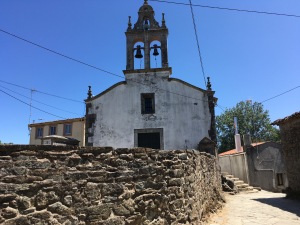

We spent all evening in Melide, where we had a chance to visit a number of older historical points of interest. Since it was a national holiday, however, we were unable to enter any of the museums or other public buildings. Fortunately, there were a few restaurants open along the main street through town. We are thankful that they stayed open for pilgrims.
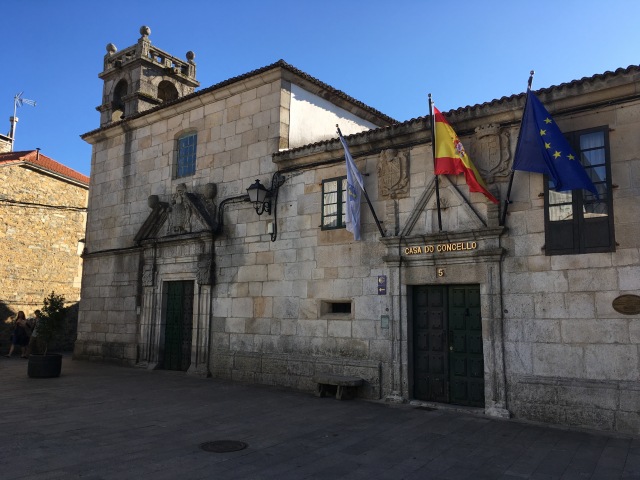
Municipal Council Building across the square from the Parochial Church, Melide
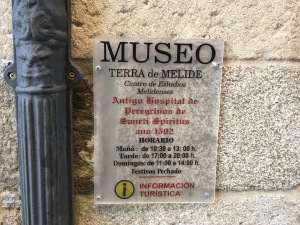
This museum in Melide is housed in the old pilgrim hospital that dates back to 1502.

A Romanesque church on the main street in Melide
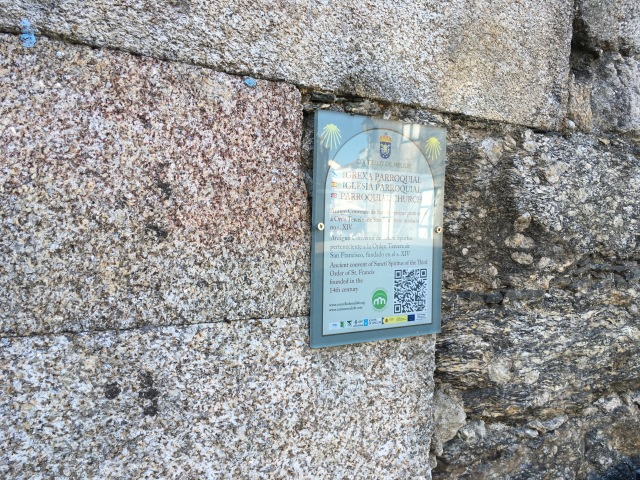
A plaque on the side of the Parochial Church where we celebrated mass on the Feast of St. James the Apostle in Melide.
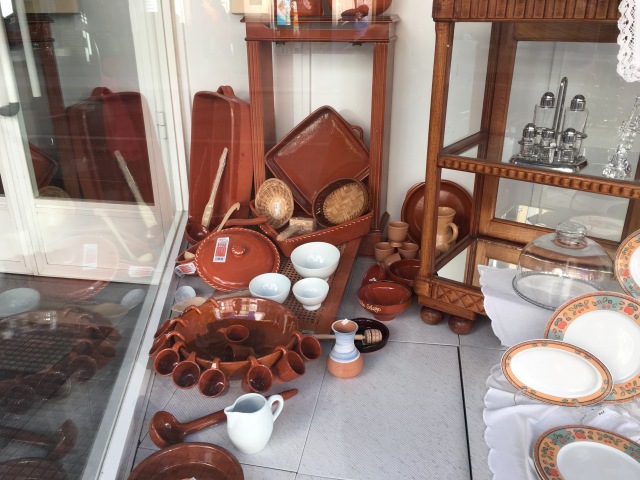
A ceramic shop window on a small street near the Parochial Church in Melide
This photo shows my backpack at a table in the garden of an albergue along the Camino. This is such a typical scene that I wanted to share it. Gardens such as this can get very crowded, but we were out around mid-day and didn’t encounter many people here:

Everyone makes sure to fill their water bottle at each rest stop along the way. You can see that my backpack is not gigantic, yet it was sufficient for the absolute necessities. Many people make the mistake of carrying too large a backpack and loading it up with too many heavy items. Not only does this cause back pain and very sore muscles – it can actually result in having to abandon the Camino for several days or altogether. A good book on what to take along will help you to avoid this mishap. The only things I took were several sets of underclothes, two pairs of cotton pants, two pairs of shorts, one long-sleeve and several short-sleeve tops, 6 pairs of socks and a few toiletries, plus my smart phone (for camera use only – no email, texting or internet searches during the pilgrimage) and flute. I did not weigh my pack, but am fairly certain that it weighed no more than 10% of my total body weight. This is definitely a case of less is more!
Next time we’ll visit the beautiful countryside around O Coruna as we enter the long stretch into Santiago de Compostela on the final two days of our Camino. I mentioned in earlier posts that the most important part of the Camino for me was the actual walk in the countryside. While I enjoyed the cities and towns that we visited, there is something incredibly special about being out in nature and close to the earth. Everything is quiet and peaceful there, interrupted only occasionally by other pilgrims chatting or crossing a street with traffic in order to get back on the dirt paths that are a major part of the Camino in Galicia. I have read that other parts of the Camino in larger cities take pilgrims along highways and other main roads. This is less appealing to me, as I am no longer a city person. Life in a small city like Santa Fe has spoiled me, and I no longer enjoy big cities.
When we get to our final destination, Barcelona, you will see many fascinating photos of this incredible, exciting and historic city. During the planning stages of our trip, Barcelona stood out in my mind as a really important final destination. I had lived in Europe for ten years in the 1980s and 90s, yet never had the chance to visit Barcelona, the birthplace of so many great artists. Barcelona was definitely on my Bucket List. Nevertheless, I found the crowds and cramped alleyways of the Old City quite oppressive, especially after spending several weeks in smaller cities and towns, and nearly a week in the countryside.
It was rather nice to walk all the way down Las Ramblas to the ocean. For a moment one could feel less hemmed in by walls of people and buildings. The one exception in Barcelona was our time in Antoni Gaudi’s magnificent Sagrada Familia. Inside the cathedral it was incredibly cool, peaceful, inspirational and meditative.
But I get ahead of myself. We still have two days on the Camino and three days in Santiago de Compostela!
#NMPAS
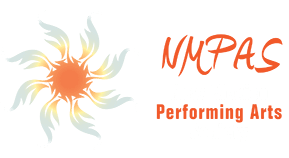
Leave a Reply
Want to join the discussion?Feel free to contribute!